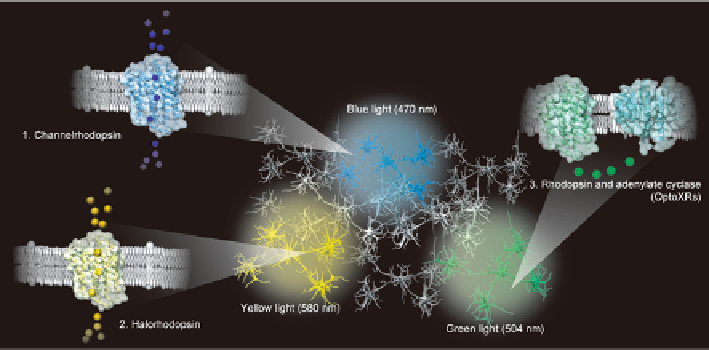Biomedical Engineering Reference
In-Depth Information
Fig. 8.2
Examples of optogenetics. Membrane excitability is manipulated using various optoge-
netic tools. ChR2 and NpHR allow us to excite and inhibit particular neurons, respectively, and
thereby to control excitability by applying different excitation wavelengths even when these modi-
fi ed neurons coexist in a particular region of interest. Similarly, intracellular signaling can also be
modifi ed with light-triggered G-proteins, “OptoXRs.” The colored balls in
blue
,
yellow
, and
green
indicate cation, anion, and intracellular signal, respectively
subsequent conformational change in the channel protein to open the pore, allowing
various cations—such as H
+
, Na
+
, K
+
, and Ca
2+
—to fl ow (Nagel et al.
2003
; Bamann
et al.
2008
). ChR2 has several features that make it particularly attractive as a neu-
roscience probe to depolarize neurons. First, the channel can be activated very rap-
idly and closes quickly upon light offset. 13-
cis
-retinal relaxes back to the all-
trans
form within milliseconds, closing the pore and stopping the fl ow of ions into or out
of the cell. Therefore, single action potentials can be generated with a brief pulse of
blue light, without any accompanying inappropriate effects of stimulation. Second,
retinal is already present in most vertebrate cells in the form of vitamin A, which
allows the ChR2 apoprotein to become a light-sensitive holoprotein. Therefore, the
extraretinal is not needed when ChR2 is used in vertebrate neural systems, although
exogenous application is necessary for invertebrate systems. Finally, as a geneti-
cally encoded protein, ChR2 permits cell-specifi c targeting with defi ned promoter
and enhancer elements. Taken together, these properties of ChR2 allow researchers
to stimulate particular neurons of interest with millisecond-level temporal resolu-
tion (Boyden et al.
2005
; Li et al.
2005
).
Recently, various opsins have been developed that can help us to analyze brain
functions effectively. The red-shifted opsin VChR1, for example, is useful when an
additional wavelength of light is required for excitation, while step-function opsins
(SFOs) can inject a stable step current to allow a positive shift in membrane poten-
tial for up to 30-60 s with a single brief pulse, after which channel closure can be
triggered by a brief exposure to yellow light.

